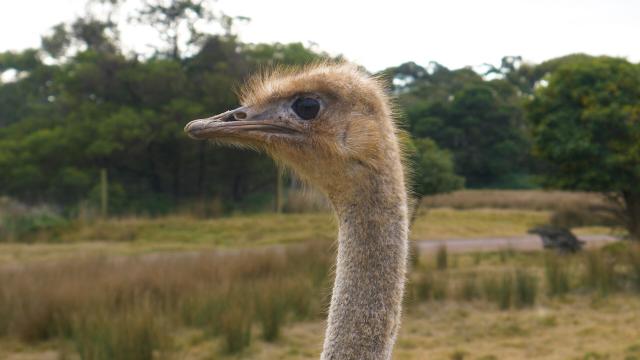At five times bigger than a human’s, an Ostrich’s eye is perfectly adapted to monitor for predator species over long distances.
So, when one of Werribee Open Range Zoo’s female Ostrich developed a mysterious eye infection, some big machinery was required.
The Ostrich was transported to the University of Melbourne’s U-Vet Werribee Animal Hospital, where she received a specialist CT scan capable of producing a three-dimensional image of the large eye – one of the first in Australia for an ostrich under anaesthetic.
Affectionately referred to as Blinkie, the five-year-old giant bird was born with a congenital issue that caused a deformity of the lower left eyelid.
Werribee Open Range Zoo Veterinarian Brett Gardner said an animal’s eyelids play an essential role in protecting the delicate eyes and tissue around them.
“Eyelids have the important function to protect the cornea from irritants and help to keep the eye from drying out,” Dr Gardner said.
“Without being able to close her eye fully, there was a greater risk of infection from a foreign body, such as dirt or grass seeds.
“After our initial assessments, we were confident an infection was hiding within the skull, behind the eye, and the only way to be sure was to create a three-dimensional image of her head.
“CT Scans are a type of X-ray that allow us to see a three-dimensional image of the body, including bone, organs and
tissue. In a two-dimensional X-ray, large sections of bone, like a skull, make it difficult to see inflammation or damage to the tissue behind.
“What we discovered through this process was an abscess hiding deep behind her eye, just outside the sinuses.” Thanks to a course of antibiotics, the abscess reduced in size and drained naturally without the need for invasive surgeries.
Blinkie has now returned to her flock that resides on the zoo’s Savannah.
Zookeepers are continuing to monitor her eye health and provide a topical ointment to prevent reinfection.
Werribee Open Range Zoo would also like to acknowledge the specialist veterinary ophthalmologists at Melbourne Eye Vet for their assessment, expertise, and investigation into the eye condition of the Ostrich.
The Ostrich is the world’s largest bird, standing as tall as 2.7 metres.
While they cannot physically fly, they use their wings like rudders to balance, steer and change direction.
They are also the world’s fastest flightless bird and can cover as much as five metres in a single stride.
Zoos Victoria members and Werribee Open Range Zoo visitors are reminded that all tickets must be pre-booked online at zoo.org.au.







